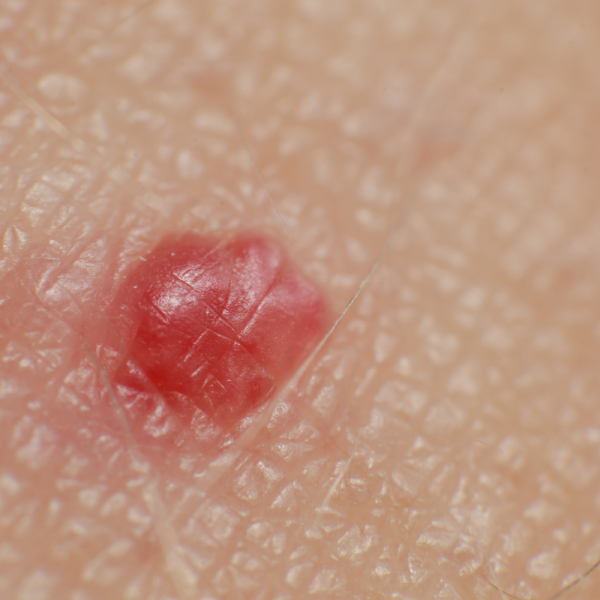
What is an angioma?
An angioma is a malformation of the vessels in which the affected vessels form an increased inner layer. The disease is usually congenital, but in rather rare cases it can also develop in adulthood through so-called haemangiomas. Some people are almost covered with dot-like skin sponges as they get older. Angiomas can develop on the face or organs and usually disappear on their own, so they are not considered dangerous. Angiomas can be removed by laser therapy or surgery if they are unsightly or cause irritation.
How does an angioma develop?
It is not yet clear to doctors why angiomas form. However, hereditary causes are possible, especially if they occur all over the body. Although angiomas are usually never considered dangerous, they can sometimes hide serious diseases, such as cirrhosis of the liver.
What are the different types of angiomas?
Doctors distinguish between many types of angiomas, but they can be divided into the two main groups based on their origin:
- Haemangiomas: These are benign tumours of the blood vessels, which in most cases are congenital and are also colloquially called blood sponges or strawberry spots. They occur particularly frequently in the mouth, kidneys or liver and disappear by themselves during the first years of life, even without therapy.
- Vascular malformations: describe anomalies that disappear on their own, similar to haemangiomas. The most common type of agioma that is due to a vascular malformation is the arteriovenous malformation. It occurs between an artery and a vein and carries a high risk of bleeding, which can rupture the vessel. An arteriovenous malformation can have serious consequences, especially in the brain. So-called cavernomas are also part of a vascular malformation. Cavernomas are caused by an accumulation of altered veins and are benign. Even slight pressure can cause bleeding and, if undetected, can lead to headaches, paralysis or seizures.
What symptoms do angiomas cause?
If angiomas occur in the brain, the following symptoms may occur:
- Angioma haemorrhage: this occurs in 2 to 4 percent of all cases and is manifested by neurological deficits, a loss of consciousness and/or acute headaches. An angioma haemorrhage in the brain can have life-threatening consequences.
- Seizures: an angioma can cause seizures due to a lack of oxygen.
- neurological deficits: If an angioma causes disturbed blood flow to the brain, this can lead to visual and/or speech disorders, paralysis, but also changes in character.
If angiomas are located elsewhere, they usually do not cause any symptoms, but can grow to a size of a few millimetres to a few centimetres. If they are located in an unfavourable place, angiomas can cause irritation. This is especially the case if the angioma is located in a fold of skin or in the armpit and some friction is caused not only by other parts of the body but also by clothing. This circumstance can not only accelerate the growth of the angioma, but also cause symptoms such as pain, bleeding or inflammation.
How are angiomas diagnosed?
If they are skin angiomas, they can be diagnosed with the naked eye. They are visible as small, flat to raised, red nodules and are usually harmless.
If they are located elsewhere, they can be diagnosed by imaging procedures, for example by showing the artery with a contrast medium (angiography) or a magnetic resonance imaging (MRI). In many cases, angiomas are diagnosed as incidental findings unless they have caused symptoms before.
How is an angioma treated?
In most cases, an angioma does not need treatment because it either goes away on its own over time or is harmless. However, because angiomas are often considered unsightly, they can be removed either by laser treatment or surgery. The treatment depends on the size and location of the angioma. While laser treatment is often used for skin angiomas, surgery is used to completely remove the angioma from the skin. This laser treatment can be performed by dermatologists who are specialised in the field of haemagiomas. If surgical removal is considered, the patient can consult a specialist in vascular surgery.
If it is a cavernoma or an arteriovenous malformation that is located in the brain and causes neurological symptoms, surgical removal or treatment with so-called neuroradiologist coil embolisation is usually used. In this procedure, the patient is put under general anaesthesia and a microcatheter is inserted into the corresponding blood vessel. Platinum coils are used to fill the aneurysm. This procedure is usually performed by a neurologist and has the advantage of being less invasive.
If angiomas cause bleeding or tend to form blood clots, they can be treated with medication containing the active ingredient propranolol or cold therapy (cryotherapy) as an alternative to surgery or laser therapy, depending on their location and size.
What is the prognosis for an angioma?
While smaller haemangiomas usually resolve spontaneously and heal without residual symptoms, larger angiomas can often leave dilated skin vessels, scars, colour changes on the skin and/or thinner skin. If angiomas are diagnosed due to an existing haemorrhage and are then treated, the prognosis depends on the timing of the treatment. If the haemorrhage (especially in the brain) has been present for a long time, permanent damage may have occurred, which should be assessed by a neurologist.
| Pathogen | Source | Members - Area |
|---|---|---|
| Angioma | EDTFL | As a NLS member you have direct access to these frequency lists |
